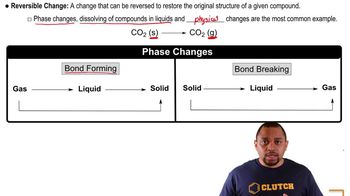The value of Ka for nitrous acid (HNO2) at 25 °C is given in Appendix D. (d) What is the value of ΔG when [H+] = 5.0⨉10-2 M, [NO2-] = 6.0⨉10-4 M, and [HNO2] = 0.20 M?
(c) How many reversible paths are there between two states of a system?
 Verified step by step guidance
Verified step by step guidanceKey Concepts
Reversible Processes

State Functions

Thermodynamic Paths

The Kb for methylamine (CH3NH2) at 25 °C is given in Appendix D. (a) Write the chemical equation for the equilibrium that corresponds to Kb.
The Kb for methylamine (CH3NH2) at 25 °C is given in Appendix D. (d) What is the value of ΔG when [H+] = 6.7 × 10-9 M, [CH3NH3+] = 2.4 × 10-3 M, and [CH3NH2] = 0.098 M?
(a) Which of the thermodynamic quantities T, E, q, w, and S are state functions? (b) Which depend on the path taken from one state to another?
(d) For a reversible isothermal process, write an expression for ΔE in terms of q and w and an expression for ΔS in terms of q and T.
The crystalline hydrate Cd(NO3)2⋅4 H2O(s) loses water when placed in a large, closed, dry vessel at room temperature: Cd(NO3)2⋅4 H2O(s) → Cd(NO3)2(s) + 4 H2O(g) This process is spontaneous and ΔH° is positive at room temperature.
(a) What is the sign of ΔS° at room temperature?
